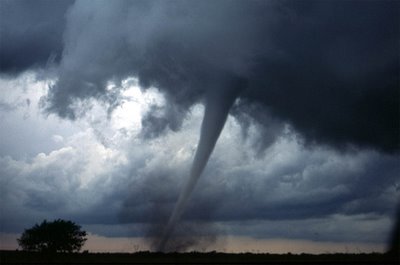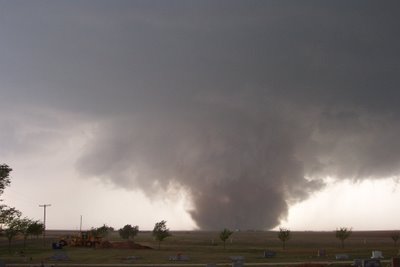 One of several tornadoes observed by the VORTEX-99 team on May 3, 1999, in central Oklahoma. Note the tube-like condensation funnel, attached to the rotating cloud base, surrounded by a translucent dust cloud.
One of several tornadoes observed by the VORTEX-99 team on May 3, 1999, in central Oklahoma. Note the tube-like condensation funnel, attached to the rotating cloud base, surrounded by a translucent dust cloud.Tornadoes can be the most destructive storms on earth. Most have winds of 110 mph (175 km/h) or less, are approximately 250 feet (75 meters) across, and travel a mile (1.6 km) or more before dissipating. However, some tornadoes can have winds of more than 300 mph (480 km/h), be more than a mile (1.6 km) across, and stay on the ground for dozens of miles (more than 100 kilometers).
They have been observed on every continent except Antarctica; however, a significant percentage of the world's tornadoes occur in the United States. This is mostly due to the unique geography of the country, which allows the conditions which breed strong, long-lived storms to occur many times a year. Other areas which often experience tornadoes are south-central Canada, northwestern Europe, east-central South America, South Africa, and south-central Asia.
The word "tornado" comes from the Spanish word tronada ("thunderstorm"), altered by the folk etymology tornar ("to turn"). Some common, related slang terms include: twister, whirlwind, wedge, funnel, willy-willy, finger of God, Devil's tail, cyclone, rope, or stovepipe. However, willy-willy usually refers to a dust devil in Australia.
In the United States, an average tornado is around 500 feet (150 m) across, and stays on the ground for 5 miles (8 km). While this is the average, there is an extremely wide range of tornado sizes, even for typical tornadoes.
Weak tornadoes, or strong but dissipating tornadoes, can be exceedingly narrow, sometimes only a few feet across. In fact, a tornado was once reported to have a damage path only 7 feet (2 m) long.
On the other end of the spectrum, wedge tornadoes can have a damage path a mile (1.6 km) wide or more. A tornado which affected Hallam, Nebraska on May 22, 2004 was at one point 2.5 miles (4 km) wide.
In terms of path length, some meteorologists believe that the Tri-State Tornado, which affected parts of Missouri, Illinois, and Indiana on March 18, 1925, was on the ground continuously for 219 miles (352 km). However, without a modern damage survey, it is impossible to determine whether or not the deadly event was a single tornado or a series of violent tornadoes produced by the same storm. The longest modern-day damage path was caused by a tornado which was on the ground for 160 miles (260 km) in northeastern North Carolina on November 22, 1992.

A tornado near Norton, Kansas, on June 24, 1909. From "Monthly Weather Review," July 1919, p. 448.
Tornadoes normally rotate in a cyclonic direction (counterclockwise in the northern hemisphere). Larger-scale storms always rotate cyclonically because of the Coriolis effect; however, tornadoes are too small in scale to be directly affected by the rotation of the earth. Approximately 1 tornado in 100 rotates in an anticyclonic direction. Typically, only landspouts and gustnados rotate anticyclonically. However, on very rare occasions, an anticyclonic supercell can develop, producing a tornado that is typical except for its direction of rotation.
Though scientists have learned much from years of research, there are still many things about tornadoes which remain a mystery. In fact, scientists still don't know exactly how a rotation in the middle of the thunderstorm descends to become a tornado. Research programs, including VORTEX, deployment of TOTO (the TOtable Tornado Observatory), and dozens of other programs, hope to solve many questions that still plague meteorologists.


No comments:
Post a Comment